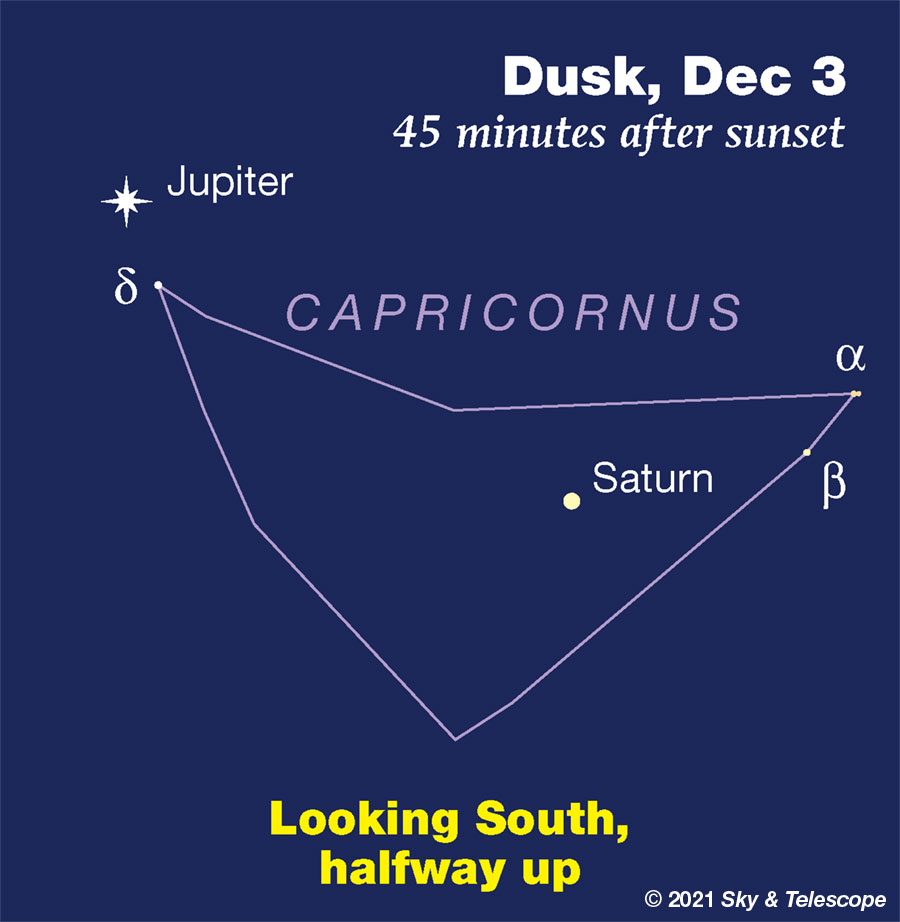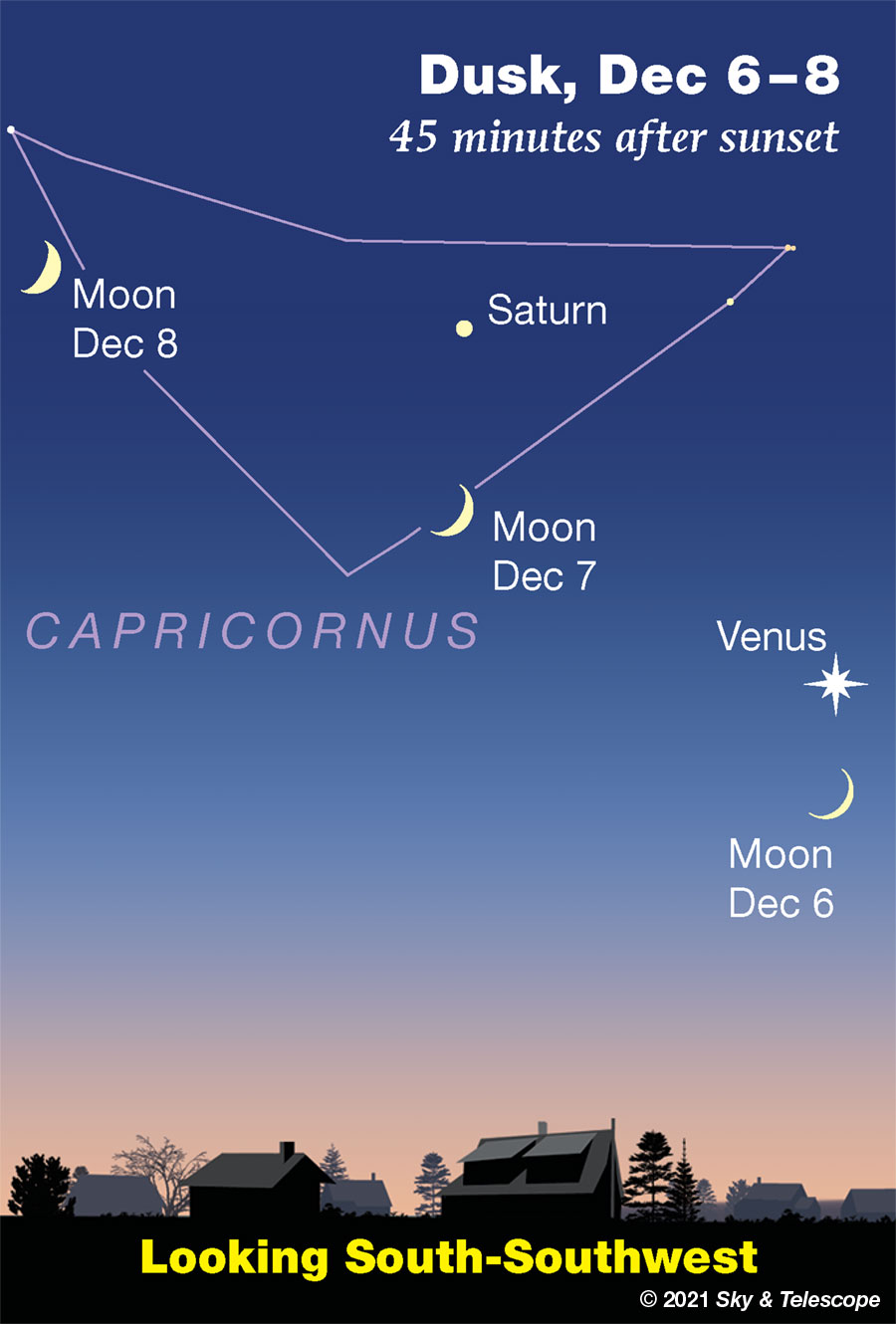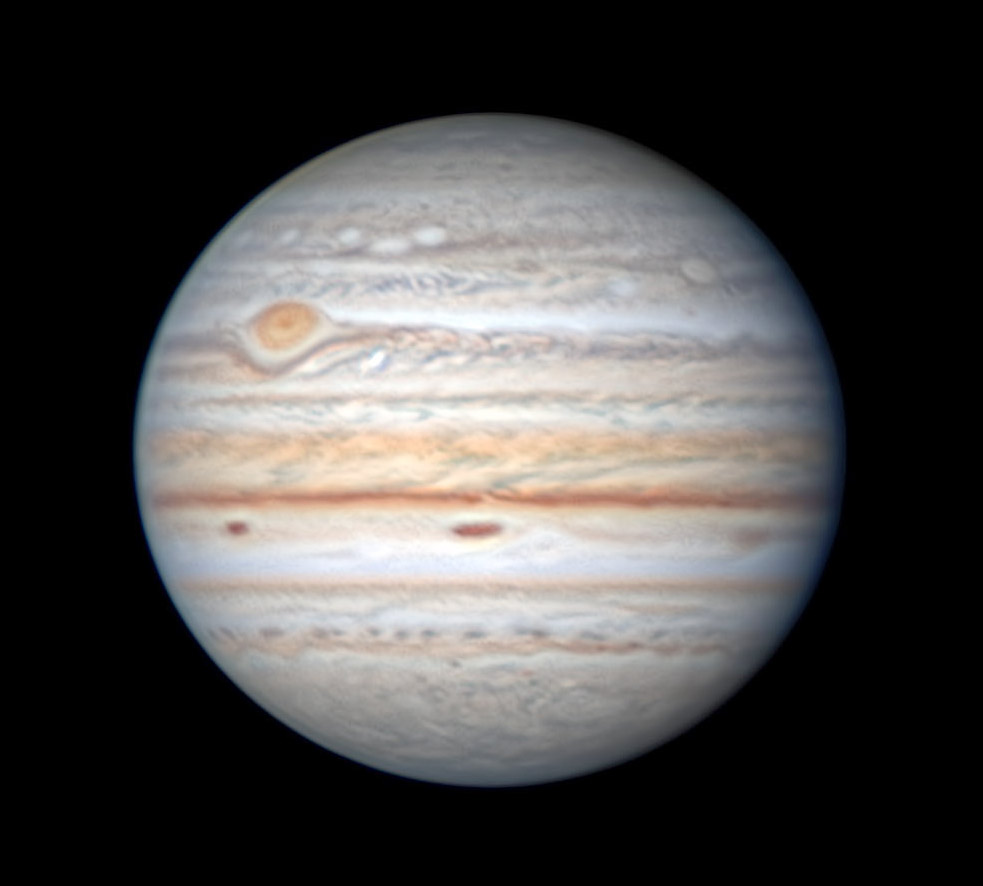FRIDAY, DECEMBER 3
■ Comet Leonard (C/2021 A1) is having its best week! It's about 6th magnitude or fainter, high in the east before the very first light of dawn in the vicinity of Arcturus. The morning of December 4th finds it 9° upper left of Arcturus as seen from North America.
The comet should peak around magnitude 4.5 or 5 — still needing binoculars or a telescope or a very dark sky (a comet is more diffuse than a star) — around December 10th or 11th. By then it'll be much lower at the beginning of dawn, however, starting to lose its battle with morning twilight. Online article: See Comet Leonard at its Best. You'll need the detailed charts at the bottom of it to pinpoint the location to examine.
Update: Using 10 x 50 binoculars on the morning of December 4th through suburban light pollution, I found the comet without much difficulty using the detailed chart. Seen though my fairly mediocre, all-too-ordinary sky, the comet was a subtle, diffuse glow with little or no central condensation; round, and with no sign of a tail. Compared to the globular cluster M3 almost in the same field, the comet was dimmer by more than a magnitude (i.e. about 7), somewhat larger, and lacking the cluster's concentration toward the center. Be careful not to confuse the two; M3 is more visible.

■ Venus and Jupiter, the two brightest celestial objects after the Sun and Moon, continue to blaze during and after twilight this week. Venus dazzles in the southwest. Jupiter shines some 30° to Venus's upper left, high in the south to south-southwest. As twilight fades, dimmer Saturn emerges midway between them.
SATURDAY, DECEMBER 4
■ This evening Saturn appears exactly halfway between Jupiter and Venus; look during late twilight or shortly after. Although Saturn is a very respectable magnitude +0.7, the other two quite overpower it.
■ For West Coasters, Algol in Perseus should be in eclipse at its minimum brightness, magnitude 3.4 instead of its usual 2.1, for a couple hours centered on 11:49 p.m. PST. Algol takes several additional hours to fade and to rebrighten.
■ New Moon (exact at 2:43 a.m. on this date Eastern Standard Time).
■ Total eclipse of the Sun for parts of West Antarctica. A partial eclipse occurs for all of Antarctica and much of the Southern Ocean, and it nicks South Africa. See the December Sky & Telescope, page 50.
SUNDAY, DECEMBER 5
■ Vega still shines brightly well up in the west-northwest after dark. The brightest star above it is Deneb, the head of the big Northern Cross formed by the brightest stars of Cygnus. At nightfall the shaft of the cross extends lower left from Deneb. By about 11 p.m., it plants itself more or less upright on the northwest horizon.
■ Now that it's December, Orion is striding up clear of the east-northeast horizon by 7 or 8 p.m. By 9 or 10 he's displaying himself high in the southeast in his full wintry glory. Have you looked in on the Great Orion Nebula yet this season? Here's your chance before moonlight starts to flood the sky again. Orion is highest in the south around midnight.
MONDAY, DECEMBER 6
■ The waxing crescent Moon hangs with Venus low in the southwest early this evening, as shown below.

■ What's the next most attractive star cluster in Taurus after the Pleiades and Hyades? Maybe it's NGC 1647, between the horns of Taurus just a few degrees from Aldebaran and the Hyades. Matt Wedel calls it "a wonderful object for binoculars" in a really dark sky. It's largish but loose.
The cluster's location is easy: It forms a roughly equilateral triangle with Aldebaran and the other tip of the Hyades V. (The cluster is actually centered 1° southeast of, i.e. currently below, the point that makes the equilateral triangle perfect.) Just off the cluster's south edge you'll find "a fine optical double star," Matt writes, very wide and unequal, both orange, magnitudes 6.0 and 7.5. Have a careful look using the chart with his Binocular Highlight column in the December Sky & Telescope, page 43.
Some, however, would instead bestow the rank of third-place Taurus cluster on NGC 1746, also between the Taurus horns. It's larger and a little more photogenic and eye-catching, located 3/5 of the way from Aldebaran to Beta Tauri. (NGC 1647 is 1/5 of the way along that same line.) The two clusters often get confused — not least because their NGC numbers are the same digits rearranged.
TUESDAY, DECEMBER 7
■ Now the Moon hangs below distant Saturn, between Venus to their lower right and Jupiter to their upper left.
WEDNESDAY, DECEMBER 8
■ Now the Moon hangs lower right of Jupiter. Look farther to their lower left for sparklier Fomalhaut.
■ As the stars come out, the Cassiopeia W stands on end (its fainter end) high in the northeast. Watch Cas turn around to become a flattened M, even higher in the north, by late evening.
■ This is the time of year when M31, the Andromeda Galaxy, passes your zenith after dinnertime (if you live in the mid-northern latitudes). The exact time depends on your longitude; it happens at 7:30 p.m. if you happen to live at your time zone's standard longitude. Binoculars, or your eyes alone under a dark sky, will show M31 just off the upraised knee of the Andromeda constellation's stick figure. See the big evening constellation chart in the center of Sky & Telescope.
THURSDAY, DECEMBER 9
■ Orion is up after dinnertime low in the east-southeast, and that means Gemini is also coming up to its left (for the world's mid-northern latitudes). The head stars of the Gemini twins, Castor and Pollux, are at the left end of the Gemini constellation — one over the other, with Castor on top.
FRIDAY, DECEMBER 10
■ First-quarter Moon (exactly so at 8:36 p.m. EST). The half-lit Moon shines far off the upper-left end of the Venus-Saturn-Jupiter line, turning it into an immense, gently curving line of four objects.
■ Algol should be at minimum light for a couple hours centered on 8:27 p.m. EST.
SATURDAY, DECEMBER 11
■ At this time of year the Big Dipper lies shyly down at its lowest just after dark, due north. It's entirely below the north horizon if you're as far south as Miami.
But by midnight the Dipper stands straight up on its handle in fine view in the northeast — while Cassiopeia has wheeled over to the northwest to stand nearly upright on the bright end of its W shape.
■ Seen any early Geminid meteors yet? The shower is due to peak in two days, late on the night of December 13-14.
This Week's Planet Roundup
Mercury is out of sight in the glare of the Sun.
Venus, a dazzling magnitude –4.9, shines in the southwest during and after twilight.
Mars, far and faint at magnitude +1.6, is emerging low in the sunrise. Look just above the east-southeast horizon about 50 minutes before sunup, way down below Arcturus and Spica.

The South Equatorial Belt, with the Great Red Spot in its southern edge, is mostly pale. The North Equatorial Belt is relatively dark red along its south edge and sports two dark red barges in the image above.
Color and brightness contrasts are exaggerated here, compared to Jupiter's whiter, flatter visual appearance. This is done in virtually every photo of the planet you ever see, to bring out details.
Jupiter, in Capricornus, shines in the south to southwest during evening far upper left of Venus. At magnitude –2.3 Jupiter is second in brightness only to Venus.
Look two fists lower left of Jupiter for sparkly Fomalhaut, magnitude +1.2.
Saturn, also in Capricornus, is midway between Jupiter and Venus. At magnitude +0.7, Saturn is only 1/16 Jupiter's brightness.
Saturn sets around 8 or 9 p.m. Jupiter follows it down a little more than an hour later.
Uranus (magnitude 5.7, in southern Aries) is very high in the east-southeast after dark. See Bob King's story and finder chart.
Neptune (magnitude 7.9, at the Aquarius-Pisces border) is high in the south after dark.
All descriptions that relate to your horizon — including the words up, down, right, and left — are written for the world's mid-northern latitudes. Descriptions and graphics that also depend on longitude (mainly Moon positions) are for North America.
Eastern Standard Time, EST, is Universal Time (also called UT, UTC, GMT, or Z time) minus 5 hours.
Want to become a better astronomer? Learn your way around the constellations. They're the key to locating everything fainter and deeper to hunt with binoculars or a telescope.
This is an outdoor nature hobby. For an easy-to-use constellation guide covering the whole evening sky, use the big monthly map in the center of each issue of Sky & Telescope, the magazine of the American Astronomical Society.
Once you get a telescope, to put it to good use you'll need a detailed, large-scale sky atlas (set of charts). The basic standard is the Pocket Sky Atlas (in either the original or Jumbo Edition), which shows stars to magnitude 7.6.

Next up is the larger and deeper Sky Atlas 2000.0, plotting stars to magnitude 8.5; nearly three times as many. The next up, once you know your way around, are the even larger Interstellarum atlas (stars to magnitude 9.5) or Uranometria 2000.0 (stars to magnitude 9.75). And be sure to read How to Use a Star Chart with a Telescope.
You'll also want a good deep-sky guidebook, such as the big Night Sky Observer's Guide set by Kepple and Sanner.
Can a computerized telescope replace charts? Not for beginners, I don't think, and not on mounts and tripods that are less than top-quality mechanically, meaning heavy and expensive. And as Terence Dickinson and Alan Dyer say in their Backyard Astronomer's Guide, "A full appreciation of the universe cannot come without developing the skills to find things in the sky and understanding how the sky works. This knowledge comes only by spending time under the stars with star maps in hand."
![]() Audio sky tour. Out under the evening sky with your
Audio sky tour. Out under the evening sky with your
earbuds in place, listen to Kelly Beatty's monthly
podcast tour of the heavens above. It's free.
"The dangers of not thinking clearly are much greater now than ever before. It's not that there's something new in our way of thinking, it's that credulous and confused thinking can be much more lethal in ways it was never before."
— Carl Sagan, 1996
"Facts are stubborn things."
— John Adams, 1770
 4
4








Comments
Rod
December 3, 2021 at 9:41 am
Some folks posted observations of comet Leonard. This morning, I enjoyed viewing the comet within about 47 arcminutes of M3, globular cluster. Here is my report 🙂
"Observed 0500-0600 EST/1000-1100 UT. Sunrise 0708 EST/1208 UT. Stellarium 0.21.2 reports comet Leonard magnitude 6.22. Starry Night Pro Plus 8 reports magnitude 6.21. M3 reported at 6.88 Starry Night, Stellarium 6.20. theskylive.com site reports comet Leonard this morning magnitude 7.4. Using my 90-mm refractor telescope and 32-
mm plossl eyepiece at 31x, theskylive.com magnitude looks accurate for the comet reported as 7.4. A diffuse coma near 9-arcminute angular size for the comet and M3 distinctly brighter in the FOV. True FOV ~ 96-arcminutes at 31x. Starry Night and Stellarium show about 47 arcminute angular separation between M3 and comet Leonard this morning near 0530 EST/1030 UT. While observing a Starlink satellite passed by the eyepiece FOV perhaps 4th magnitude, nearly between M3 and comet Leonard in their positions in the sky. Stellarium showed Starlink satellites passing by Canes Venatici and Bootes this morning before sunrise. In Leo, a meteor flashed and burned up, leaving a smoke train or trail that I could see using 10x50 binoculars easily. I first observed M3 and comet Leonard using 10x50 binoculars and then the telescope. The Telrad targeting device made it easy to locate and view. Perhaps someone will get an astrophotography
image of the pair. I enjoyed the early morning views of M3 and Leonard this morning. Skies clear and temperature near 7C with west winds 10 knots."
You must be logged in to post a comment.
fuelman
December 4, 2021 at 9:44 am
very good report. bravo!
You must be logged in to post a comment.
Rod
December 7, 2021 at 7:00 am
Well, I thought I was going to view comet Leonard again this morning. The telescope was ready and my 10x50 binoculars go for launch. I went out, and what did I see? Plenty of cirrus clouds rolling in covering most of the sky 🙂 Stellarium and Starry Night show the comet a bit more than 2-degrees angular separation from Xi Bootis star. Okay, I went back inside and had hot coffee and breakfast on a morning with temperature 0C and winds from the west 5 knots or so. I tried from 0445 EST until 0615 EST, but clouds did not allow comet views. Perhaps another day will be better for viewing the comet again 🙂 Perhaps I will need to wait and observe Santa riding across the night sky on Christmas Eve 🙂
You must be logged in to post a comment.
Rod
December 9, 2021 at 7:56 am
FYI, I posted a comet Leonard observation report update for early this morning at Bob King's report page. https://skyandtelescope.org/observing/celestial-objects-to-watch/comets/see-comet-leonard-at-its-best/#comment-381620
The wood burning stove and hot coffee after observing, very good 🙂
You must be logged in to post a comment.
You must be logged in to post a comment.